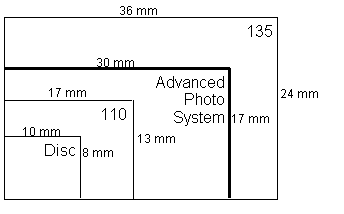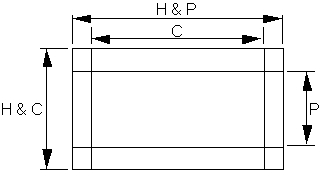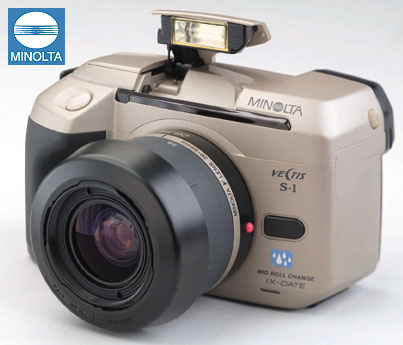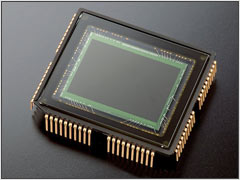Digital Photography from 20,000 Feet
by Wesley Fink on September 25, 2006 12:05 AM EST- Posted in
- Digital Camera
The Digital SLR
Several factors delayed the move to SLR technology for digital photography. First, the early sensors were much lower megapixel resolutions, far too low to begin to compete with film photography. Photo hobbyists saw few advantages to moving to a low resolution system since the reason they used an SLR was high image quality. It wasn't until resolutions reached the 2 to 4 megapixel range that there was any interest in a digital SLR.
Second, the early sensors were very small, developed primarily for video usage. Some tried to develop proprietary systems based on a smaller sensor size with more compact lenses, but nothing caught on in the industry. The cost of early sensors was also astronomical, making the early digital SLR cameras only useful for production, high volume photography where the cost could be justified.
Third, with sensor resolution and size in constant development it was much easier to design a point-and-shoot camera around each new sensor generation. Until sensor size stabilized, a digital SLR that used existing lens systems was not practical.
APS (Advanced Photo System)
35mm first appeared on the scene in the 1930s and the film format simply took 35mm motion picture film and spooled it into a light-tight canister. By the 1960s, with point-and-shoot and developments in SLR technology, 35mm had become king of the film formats. Even as film manufacturers tried to introduce other film formats, 35mm continued to grow and prosper. With the very early developments in digital photography, Kodak, Fuji and others saw the handwriting on the wall for film photography. One of the ongoing complaints about 35mm film, however, has been that the 2:3 image format required image loss in almost every standard print size. 8x10 and 5x7 are neither a 2:3 ratio and both required cropping of the 35mm negative.

In 1996 a new APS (Advanced Photo System) initiative by Kodak, Fujifilm, Minolta, Nikon, Canon and others was introduced to save film by standardizing on new ratios and adding new "computer-like" data storage capabilities in the taking and processing of images. APS included a new film size - 30.2mm x 16.7mm - that could be printed full-frame (H or HDTV format), or use standard crops of 25.1mm x 16.7mm (C or Classic 2:3 format) or 9.5mm x 30.2mm (P or Panorama). Actually, the image size that was always shot was the 30.2mm x 16.7mm, and the other sizes were just standard crops.

The industry was confident they could sell APS, which in the most common C view was only about 55% of the already small 35mm size. Some manufacturers like Minolta developed new APS lens lines with smaller cameras and lenses, and Canon and Nikon developed APS camera bodies that could mount their regular lenses - and a few custom APS lenses.

In the end, APS failed in the film market, but it is important in our discussion of Digital Photography because it was also a standard for digital development. At the time of the APS initiatives, it seemed reasonable to aim for development of digital sensors for that same APS format, so lenses for both systems were interchangeable. The industry aimed for the APS C size sensor, which would be about 16.7mm x 25.1mm the same ratio (2:3) as the classic 35mm format. This allowed existing 35mm lenses to be used, with a lens factor of 1.5 to 1.6, and the development of new lenses with a smaller image circle.
What do we mean by Lens Factor? Why does it matter?
The Lens Factor
APS really doesn't matter in the film market, except as a brief and intense flurry of activity that has produced a huge number of APS cameras in every imaginable format. Some of the high-end models are particularly interesting and will become collectibles. APS cameras like the tiny Minolta Vectis S-1 SLR system, the Canon IX, and Nikon Pronea are remarkably well-built and intelligent designs for the APS format.

The APS may be discontinued and dying in the film market, but it is alive and well in today's Digital SLR market. Today Sony, Nikon, Canon, Pentax, Minolta, Samsung and every other production SLR on the market (except Olympus) uses a sensor that is approximately APS C size. This matters because the lenses designed for 35mm SLR photography do not behave the same when used to capture images with the smaller APS sensor.
Several factors delayed the move to SLR technology for digital photography. First, the early sensors were much lower megapixel resolutions, far too low to begin to compete with film photography. Photo hobbyists saw few advantages to moving to a low resolution system since the reason they used an SLR was high image quality. It wasn't until resolutions reached the 2 to 4 megapixel range that there was any interest in a digital SLR.
Second, the early sensors were very small, developed primarily for video usage. Some tried to develop proprietary systems based on a smaller sensor size with more compact lenses, but nothing caught on in the industry. The cost of early sensors was also astronomical, making the early digital SLR cameras only useful for production, high volume photography where the cost could be justified.
Third, with sensor resolution and size in constant development it was much easier to design a point-and-shoot camera around each new sensor generation. Until sensor size stabilized, a digital SLR that used existing lens systems was not practical.
APS (Advanced Photo System)
35mm first appeared on the scene in the 1930s and the film format simply took 35mm motion picture film and spooled it into a light-tight canister. By the 1960s, with point-and-shoot and developments in SLR technology, 35mm had become king of the film formats. Even as film manufacturers tried to introduce other film formats, 35mm continued to grow and prosper. With the very early developments in digital photography, Kodak, Fuji and others saw the handwriting on the wall for film photography. One of the ongoing complaints about 35mm film, however, has been that the 2:3 image format required image loss in almost every standard print size. 8x10 and 5x7 are neither a 2:3 ratio and both required cropping of the 35mm negative.

In 1996 a new APS (Advanced Photo System) initiative by Kodak, Fujifilm, Minolta, Nikon, Canon and others was introduced to save film by standardizing on new ratios and adding new "computer-like" data storage capabilities in the taking and processing of images. APS included a new film size - 30.2mm x 16.7mm - that could be printed full-frame (H or HDTV format), or use standard crops of 25.1mm x 16.7mm (C or Classic 2:3 format) or 9.5mm x 30.2mm (P or Panorama). Actually, the image size that was always shot was the 30.2mm x 16.7mm, and the other sizes were just standard crops.

The industry was confident they could sell APS, which in the most common C view was only about 55% of the already small 35mm size. Some manufacturers like Minolta developed new APS lens lines with smaller cameras and lenses, and Canon and Nikon developed APS camera bodies that could mount their regular lenses - and a few custom APS lenses.

In the end, APS failed in the film market, but it is important in our discussion of Digital Photography because it was also a standard for digital development. At the time of the APS initiatives, it seemed reasonable to aim for development of digital sensors for that same APS format, so lenses for both systems were interchangeable. The industry aimed for the APS C size sensor, which would be about 16.7mm x 25.1mm the same ratio (2:3) as the classic 35mm format. This allowed existing 35mm lenses to be used, with a lens factor of 1.5 to 1.6, and the development of new lenses with a smaller image circle.
What do we mean by Lens Factor? Why does it matter?
The Lens Factor
APS really doesn't matter in the film market, except as a brief and intense flurry of activity that has produced a huge number of APS cameras in every imaginable format. Some of the high-end models are particularly interesting and will become collectibles. APS cameras like the tiny Minolta Vectis S-1 SLR system, the Canon IX, and Nikon Pronea are remarkably well-built and intelligent designs for the APS format.

The APS may be discontinued and dying in the film market, but it is alive and well in today's Digital SLR market. Today Sony, Nikon, Canon, Pentax, Minolta, Samsung and every other production SLR on the market (except Olympus) uses a sensor that is approximately APS C size. This matters because the lenses designed for 35mm SLR photography do not behave the same when used to capture images with the smaller APS sensor.










81 Comments
View All Comments
sliver1 - Tuesday, September 26, 2006 - link
Nice wrapping article! There is one thing that doesn't fit though...If you're a pro photographer, then you don't need such a website to learn about photography or entry-level consumer DSLR cameras. A thing like "a good auto white balance" doesn't mean anything since pros are shooting RAW anyway. Also, you don't embrace a "camera system" solely for the body and the lenses -- there are lots of other accessories required that may not be available or as good as those of the two major players with offerings from other companies. (Have you heard of pro photographers working with anything but Canon or Nikon?)
On the other hand, yes, other websites prepare extensive reviews that cover, among other things, startup times, location of mirror lockup or second curtain sync features, discuss MTF charts and review lens by talking about chromatic aberrations/distortion/corner softness, etc. -- all sort of things that that matter to pros, even if it won't be covered on this site.
Where does that leave this new Anandtech section? Inevitably to consumer or photo hobbyists/enthusiasts. This is for people who expect better image quality and more freedom in picture taking than what a point-and-shoot can offer -- yet not being anywhere near pro.
So as long as you stick with this segment, spend paragraphs talking about the "direct print" features, discuss "picture styles", explain the effective range of the built-in snap-up flash, then okay. But it would be ridiculous to write articles about top of the line cameras like the Canon 5D, Canon 1DsMkII, Nikon D2xs, etc., as much as it would be ridiculous to talk about thousand dollar pro lenses, etc.
While I'm at it...
1) You seem to believe that the crop factor has an influence on the "rule of thumb" for handheld shots. A 50mm lens, equivalent to a 80mm on a 1.6x crop, still has a "rule of thumb" of 1/50s. Keeping only a smaller part of the image circle does not lengthens a lens, does not add vibration...
2) Image Stabilisation (IS) is very handy (no pun intended), but cannot replace a faster lens. Even if you can shoot handheld 3 stops slower (or even 4 stops, as in the new Canon EF 70-200mm f/4L IS USM), this won't help for a moving subject, and you may well end up with blurry pictures after all -- especially if you're shooting people/animals...
3) You seem to diminish/discard the importance of a full-frame sensor. A full frame sensor has a dramatic impact on the quality of the images, especially because of lower pixel density. Also, the only comparison you've mentionned for film vs digital left readers to think that digital still had something to envy film -- which is really not seeing the whole picture. Digital reduced noise (grain) dramatically. It has been reported by more than a serious source that a 1DsMkII has more resolving power than *medium format film*. Color rendition is better in digital by *far*. More control over the whole workflow. All in all, digital is winning easily, which is why pros are all going digital and companies are giving up film. The only drawback is the higher initial cost.
And finally...
4) No pro relies on full-auto settings in a camera, no matter how sophisticated it is (or will become). Even if technology (what this website is about) keeps bringing tools to facilitate the photographer's job and render sharper, cleaner images, etc., that's not what makes a picture compelling. A 39MP PhaseOne digital back won't do any good in the hands of a beginner, as much as a pro could make astounding pictures with a very modest camera... So, please make sure you don't play the marketing game companies are using to have consumer believe they can make wonderful pictures with the touch of a single button ;)
silver - Tuesday, September 26, 2006 - link
" It has been reported by more than a serious source that a 1DsMkII has more resolving power than *medium format film*. Color rendition is better in digital by *far*. More control over the whole workflow. All in all, digital is winning easily, which is why pros are all going digital and companies are giving up film. "Not at all ! Pro's jumped on digital as it speeds up their entire workflow and is more effecient than film. It reduces costs significantly as most studios have film processing and proofing costs around $4,k~$5,k per month. Also having the image immediately available to the client has huge returns in sales points. These are trully the only reasons. Film is still far and away better when comparing apples-to-apples.
sliver1 - Tuesday, September 26, 2006 - link
As others have said it, at this point, there would be endless arguing about digital vs film, and I understand that some could still want to use film for obscure/critical reasons, such as shooting in harsh -60 celcius north pole conditions. ...But seriously, what I was simply trying to point out, though, is that the only mention of "film" in the article was an argument in favor of film, which doesn't allow to see the whole picture.As for why pros are switching to digital... If it was only a matter of saving on the studios' workflow, or speeding things up for photojournalists, then only some fields of photography would have made the switch. Many other pros -- in landscape photography, for example, where you can get very complex histograms pushing the range to its limits -- would have stuck to film. The fact is that they are all switching.
http://www.luminous-landscape.com/reviews/shootout...">http://www.luminous-landscape.com/reviews/shootout...
silver - Tuesday, September 26, 2006 - link
I can honestly say I don't know a single photographer shooting quality landscapes on digital. I certainly don't know any that would bother with purchasing a a $33,000 Phase One digital back for a medium format camera when a $1.00 sheet of film in a 4x5 will best it in color and tonal scale.http://www.calumetphoto.com/item/PE71278.html">http://www.calumetphoto.com/item/PE71278.html
Visual - Tuesday, September 26, 2006 - link
this is a topic with no definite outcome yet. you two can argue all you want, but especially with the nicknames you've got here it'll just look stupid ;)silver - Tuesday, September 26, 2006 - link
Who's arguing ? Digital has progressed to being nearly as good as 35mm but there is no solid documetation that I've read stating that its level of quality up to 6x4.5cm, 6x7cm, 6x9cm format film cameras.As to why pro's switched to digital, it's beyond dispute. Dollars make sense. Money talks and film took a walk. It's really that simple. Pro's have one and only one job : making money. If the quality of 8MP digital is adequate to the masses then that is what they will shoot. It doesn't matter if Mamiya has a 22MP or that you can get a $30,000 Phase One digital back for your Hasselblad. Pro's will use what is deemed acceptable or necessary by the client and that's all there is too it.
Resh - Tuesday, September 26, 2006 - link
Hate to fan these flames as this is ultimately a useless discussion, but here are some resources:http://www.luminous-landscape.com/essays/back-test...">http://www.luminous-landscape.com/essays/back-test...
http://www.luminous-landscape.com/essays/Cramer.sh...">http://www.luminous-landscape.com/essays/Cramer.sh...
N
silver - Wednesday, September 27, 2006 - link
LOL ! Hopefully you don't consider Michael Reichmann and Co. to be professionals !!!!Please, take a look at the following :
http://www.montezucker.com/">http://www.montezucker.com/
http://mattkim.com/">http://mattkim.com/
http://www.clayblackmore.com/">http://www.clayblackmore.com/
http://www.cantrellportrait.com/">http://www.cantrellportrait.com/
http://www.silvermanstudio.com/">http://www.silvermanstudio.com/
http://www.lionphotography.com/">http://www.lionphotography.com/
http://www.orangeexposure.com/">http://www.orangeexposure.com/
http://www.mattramosphotography.com/">http://www.mattramosphotography.com/
http://www.ftapia.com/">http://www.ftapia.com/
http://www.gordonmgrant.com/">http://www.gordonmgrant.com/
Yeah, these are PRO's who WORK in the field of photography ! And note that most of them don't even use the words "film" or "digital". They simply don't care what the tool is. They have a job to do and that job is to use their talents to make money. Short and simple. Digital is to the working pro as tires are to the rims on your car : a perfect fitting necessity.
wheel - Monday, September 25, 2006 - link
Hi,I am a big computer enthusiast, overclocker, IT professional and long time Anand Tech reader (since inception?) I also have been into amateur photography for about 7 years, recently switching to digi SLR about 14 months ago. All my knowledge is self taught from reading stuff on the web and my own experimentation. I use 6 lenses and have taken around 12,600 photos with my SLR camera in the time that I have owned it! (just providing a gauge of my photographic experience and enthusiasm)
I was very disappointed with this article! Firstly because it degraded other excellent websites while simultaneously borrowing content and images from them! And secondly from a technical point of view I disagreed with some of the assertions made.
What you correctly identified in your article was the flexibility of an SLR camera. However you also said a few separate times that comparing times including power-on time had now become irrelevant because they were all pretty fast? I disagree!
One use of an SLR camera is sports or action photography where start up times can be very important. Just this weekend I took pictures at a car rally, where on one day it rained heavily and on another it was very dusty. I held my camera under my jacket and only pulled it out and turned it on at the last minute so to keep it from getting too wet. I think the 350D is 0.2 seconds start up time which is fine for this use, but I would not consider a camera that forced the user to wait for much longer (for example if it needed to clean the sensor). The nature of sports photography demands more of the performance of the camera as interesting things may suddenly unfold so the performance of the camera and the ability to change settings quickly rather than navigate menus gains importance...
I think DPReview and Steves Digicams both understand that their readers may vary significantly in what they want from a camera - that is in part why they may be seen as ambiguous in their conclusions as they avoid giving cameras an overall score like 88% etc. That they cover a many technical details in the article allows the readers to decide what features are important and reach their own conclusions.
Another thing you wrote was that there weren't many positive things about zoom lenses. I have both zooms and prime lenses and appreciate that they both have strengths and weaknesses.
You also said "Canon and Nikon still make reasonable 50mm f/1.8 lenses, which also happen to be the sharpest lens in either lens lineup." Can you qualify this statement re: sharpness? The Canon 50mm 1.8 lens is cheap and pretty good but not a silver bullet. The 50mm f/1.4 beats it in all areas and is still quite reasonably priced. And of course I am sure the 50mm f/1.2 is excellent, although very expensive.
So I am sorry but I think you should have a little more respect for the established sites who have done a fantastic job over the years in the field that they specialise in. I shall read your reviews in parallel with the established camera sites but will take your opinions with a grain of salt!
For others interested in digital SLR photography I recommend the following websites:
Body reviews:
http://www.dpreview.com/">http://www.dpreview.com/
http://www.steves-digicams.com/">http://www.steves-digicams.com/
http://www.luminous-landscape.com/">http://www.luminous-landscape.com/ (also general info and lens reviews too)
Lens reviews:
http://www.fredmiranda.com/reviews/">http://www.fredmiranda.com/reviews/
http://www.slrgear.com/reviews/">http://www.slrgear.com/reviews/
http://photosig.pcphotoreview.com/">http://photosig.pcphotoreview.com/
Cheers,
Ian
Wesley Fink - Tuesday, September 26, 2006 - link
It was not my intent to degrade other excellent photo websites, in fact I mentioned no site specifically in my introductory guide. You obviously appreciate the level of some the more technical digital review sites and I certainly can appreciate where you come from. As I have stated several times, we do not want to try to emulate those sites, but to try to chart our own style. We also will not please everyone with our approach.Where we have used images that are not public domain we have attributed those images to their sources in the guide. This is an introductory guide, and not a review.
Photodo is the well-respected Swedish lens data/review site that was extablished by Lars Kjellberg and is now owned by ePHOTOzine. The Nikon AF 50mm f1.8D is rated a Photodo MTF of 4.4, while the more expensive f1.4 is rated a 4.2. The Canon 50 EF 50mm f1.8 II costs $70 and is rated a Photodo MTF of 4.2, while the earlier 50 F1.8 is rated 4.4. The $350 Canon EF 50mm F1.4 is also rated at 4.4. All 5 of these lenses are among the highest MTF rated Canon and Nikon lenses you can buy, and all significantly outperform most zoom lenses in either line. The Canon 50f1.8 at $70 is a stellar value, at half a stop slower than the 1.4 and 1/5 the price. The plastic lens mount on the II version is cheesey, but owners have not complained about durability issues.